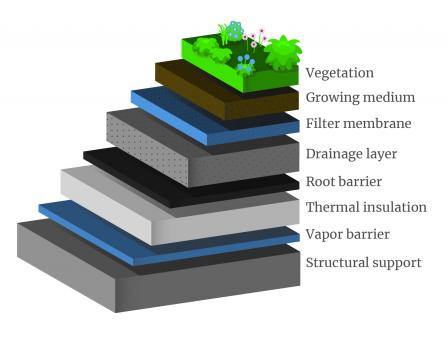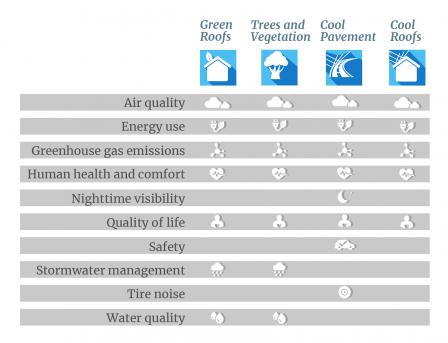Using Green Roofs to Reduce Heat Islands
- Types of Green Roofs
- Green Roofs vs. Cool Roofs
- Co-Benefits of Green Roofs
- Costs of Installing and Maintaining Green Roofs
- More Information
Green roofs have been proven to help reduce heat islands. This page provides a brief overview of the role of green roofs in mitigating the heat island effect, including green roof types, other environmental and social benefits, and cost-benefit considerations.
A green roof, or rooftop garden, is a vegetative layer grown on a rooftop. Green roofs provide shade, remove heat from the air, and reduce temperatures of the roof surface and surrounding air. Using green roofs in cities or other built environments with limited vegetation can moderate the heat island effect, particularly during the day. Green roof temperatures can be 30–40°F lower than those of conventional roofs and can reduce city-wide ambient temperatures by up to 5°F.1,2 In addition, green roofs can reduce building energy use by 0.7% compared to conventional roofs, reducing peak electricity demand and leading to an annual savings of $0.23 per square foot of the roof’s surface.1,3 These temperature reduction and energy efficiency benefits are a key contributor to the growing popularity of green roofs in the United States. In 2016, the North American green roof industry is estimated to have grown by more than 10% over 2015, continuing industry’s growth trend over the past decade. That year, a sample of industry stakeholders reported nearly 900 green roof projects totaling more than four million square feet in 40 U.S. states and six Canadian provinces.4
Types of Green Roofs
Green roofs can be installed on a wide range of buildings, from industrial facilities to private residences. There are two types of green roofs: extensive and intensive.
| Extensive Green Roofs | Intensive Green Roofs |
|---|---|
|
|
Both types of green roofs consist of the same basic layering components with a number of barriers to prevent water or root damage to the structure, a drainage layer to aid in water drainage, as well as a growing medium and vegetative layer. The Common Green Roof Layers figure (below) represents the most common design of a green roof, although not all the layers shown are found on every green roof.
Green Roofs vs. Cool Roofs
Cool roofs present another option to reduce the heat island effect. Cool roofs are made of highly reflective and emissive materials that remain cooler than traditional materials during peak temperatures. While green roofs often have initially higher costs than cool roofs, green roofs typically have a longer expected life.5 Both cool and green roofs provide benefits of lower surface and air temperatures, and decreased energy demand. However, green roofs offer added benefits such as reducing and filtering stormwater runoff; absorbing pollutants and carbon dioxide; providing natural habitat; and in the case of intensive green roofs, serving as recreational green space. Cool roofs are best suited for projects with limited budgets and a primary focus on energy savings, while green roofs are preferred when lifecycle costs, public benefits, and broader environmental impacts are of interest. Both options are important strategies for mitigating heat island effects.
Green Roofs Photo Gallery
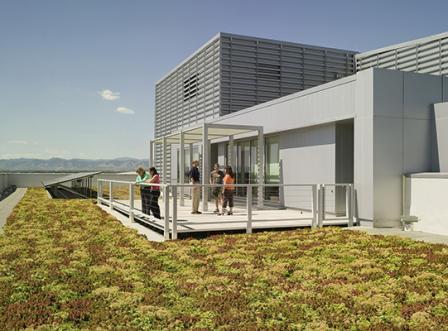 EPA Region 8 Headquarters extensive green roof – Denver, CO
EPA Region 8 Headquarters extensive green roof – Denver, CO 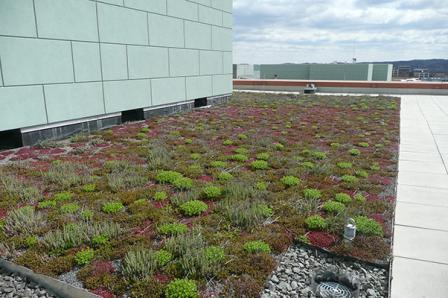 U.S. Department of Transportation Headquarters extensive green roof – Washington, DC
U.S. Department of Transportation Headquarters extensive green roof – Washington, DC 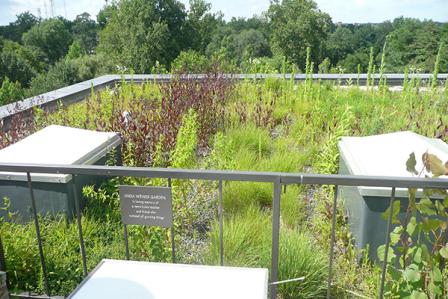 Sidwell Friends School extensive green roof – Washington, DC
Sidwell Friends School extensive green roof – Washington, DC 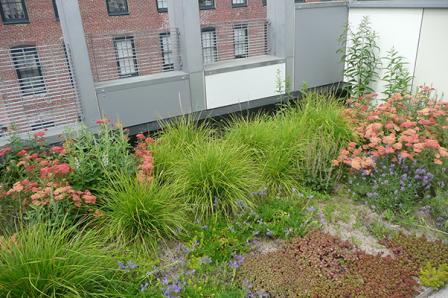 Thin Flats Sustainable Urban Community extensive green roof – Philadelphia, PA
Thin Flats Sustainable Urban Community extensive green roof – Philadelphia, PA 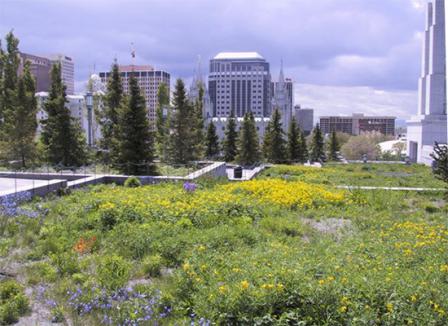 Church of Jesus Christ Latter Day Saints intensive green roof – Salt Lake City, UT
Church of Jesus Christ Latter Day Saints intensive green roof – Salt Lake City, UT 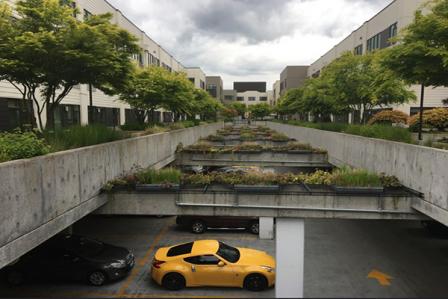 Grant Park Village Apartments intensive green roof – Portland, OR
Grant Park Village Apartments intensive green roof – Portland, OR 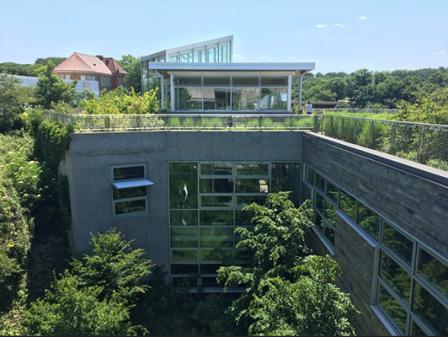 Center for Sustainable Landscape at the Phipps Conservatory and Botanical Garden intensive green roof – Pittsburgh, PA
Center for Sustainable Landscape at the Phipps Conservatory and Botanical Garden intensive green roof – Pittsburgh, PA 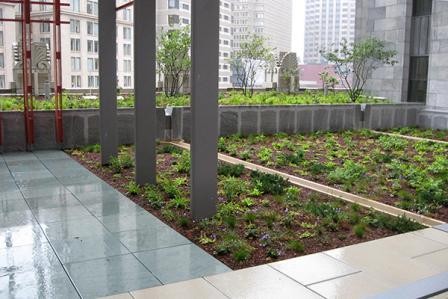 EPA Region 1 Headquarters intensive green roof – Boston, MA
EPA Region 1 Headquarters intensive green roof – Boston, MA Co-Benefits of Green Roofs
Green roofs and other heat island mitigation strategies offer a number of co-benefits (see figure below). Benefits specific to green roofs include:
- Reduced air pollution and greenhouse gas emissions: By lowering air-conditioning demand, green roofs can decrease the associated air pollution and greenhouse gas (GHG) emissions from conventional power sources. Vegetation can also remove pollutants and GHGs from the air through dry deposition and carbon sequestration and storage, respectively.
- Reduced energy use: Green roofs remove heat from the air through the process of evapotranspiration, and also act as insulators for buildings, reducing the energy needed to provide cooling and heating.
- Improved human health and comfort: Green roofs, by reducing heat transfer through the building roof, can improve indoor comfort, and lower the incidence of heat stress associated with heat waves.
- Improved quality of life: Green roofs provide aesthetic value and habitat for plant and animal species. They improve human interaction with nature by introducing green space into the built environment. Such connections to nature have been shown to benefit human physical and mental health and productivity, and reduce blood pressure and hospital stays.6
- Enhanced stormwater management and water quality: Green roofs can reduce and slow stormwater runoff in the urban environment, and also filter pollutants from rainfall. Green roofs can retain nearly all storm-related precipitation during the summer months, with lower retention during the winter months (< 20%). The actual stormwater management potential of green roofs is dependent on the season and rainfall patterns.7
Estimating the Environmental Effects of Green Roofs
The EPA-published case study, Estimating the Environmental Effects of Green Roofs, demonstrates the environmental and health benefits of green roofs for Kansas City, Missouri. The case study lays out a replicable analytical framework using free quantitative tools created by EPA and others that state and local decision-makers and practitioners can use to assess the multiple benefits of green roofs. The study found that the over 700,000 ft2 total coverage of green roofs in Kansas City installed between 1999-2020 would result in avoided emissions of 384 pounds of nitrogen oxide, 734 pounds of sulfur dioxide, and 269 tons of carbon dioxide in 2020. These emissions reductions equate to monetized health benefits of $35,500–$80,500.
Costs of Installing and Maintaining Green Roofs
The estimated costs of installing and maintaining a green roof vary by the type of green roof. For example, a simple extensive roof without public access could be as little as one-tenth to one-third of the cost to construct an intensive green roof intended for public access.8 While the initial costs of green roofs can be higher than those of conventional materials, building owners can help offset some of the differences in these costs through reduced energy costs and stormwater management fees, and potentially by the longer lifespan of green roofs compared with conventional roofing materials. Typical maintenance includes fertilization, irrigation, weed control, and replanting when necessary. Intensive green roofs might require maintenance exceeding that required for extensive roofs to maintain their aesthetic and public access uses.
Researchers at Lawrence Berkeley National Laboratory conducted a lifecycle cost analysis of green roofs, cool roofs, and conventional roofs.8 They found that while green roofs are more expensive than cool or conventional roofs, they provide significantly higher relative benefits per square foot over a 50-year lifecycle (e.g., energy cost savings, avoided emissions, reduced stormwater fees). Compared to conventional roofs, the benefits of extensive green roofs are $14 more per square foot, while cool roofs provide benefits of $2 more per square foot relative to conventional roofs.
More Information
More details on this topic are available in Chapter 3 of EPA’s Reducing Urban Heat Islands: Compendium of Strategies, which covers the following topics:
- How green roofs help to reduce heat islands
- Green roof types
- The benefits and costs of green roofs
- Other factors to consider in using green roofs
- Green roof initiatives
- Tools and resources to further explore this technology
1General Services Administration. 2011. “The Benefits and Challenges of Green Roofs on Public and Commercial Buildings.”Exit
2Santamouris, M. 2014. “Cooling the cities – A review of reflective and green roof mitigation technologies to fight heat island and improve comfort in urban environments,” Solar Energy 103:682–703.
3Sailor, D.J., T.B. Elley, and M. Gibson. 2011. “Exploring the building energy impacts of green roof design decisions – A modeling study of buildings in four distinct climates,” Journal of Building Physics 35(4):372–391. Exit
4Green Roofs for Healthy Cities. 2017. “2016 Annual Green Roof Industry Survey: Executive Summary.”
5City of Los Angeles, Environmental Affairs Department. 2006. “Green Roofs—Cooling Los Angeles (A Resource Guide).” Los Angeles, CA. Exit
6Beatley, T. and P. Newman. 2013. “Biophilic cities are sustainable, resilient cities.” Sustainability 5(8):3328–3345. Exit
7U.S. Environmental Protection Agency (EPA). 2009. “Green Roofs for Stormwater Runoff Control.”
8Sproul, J., M.P. Wan, B.H. Mandel, and A.H. Rosenfeld. 2014. “Economic comparison of white, green, and black flat roofs in the United States.” Energy and Buildings 71:20–27. Exit

